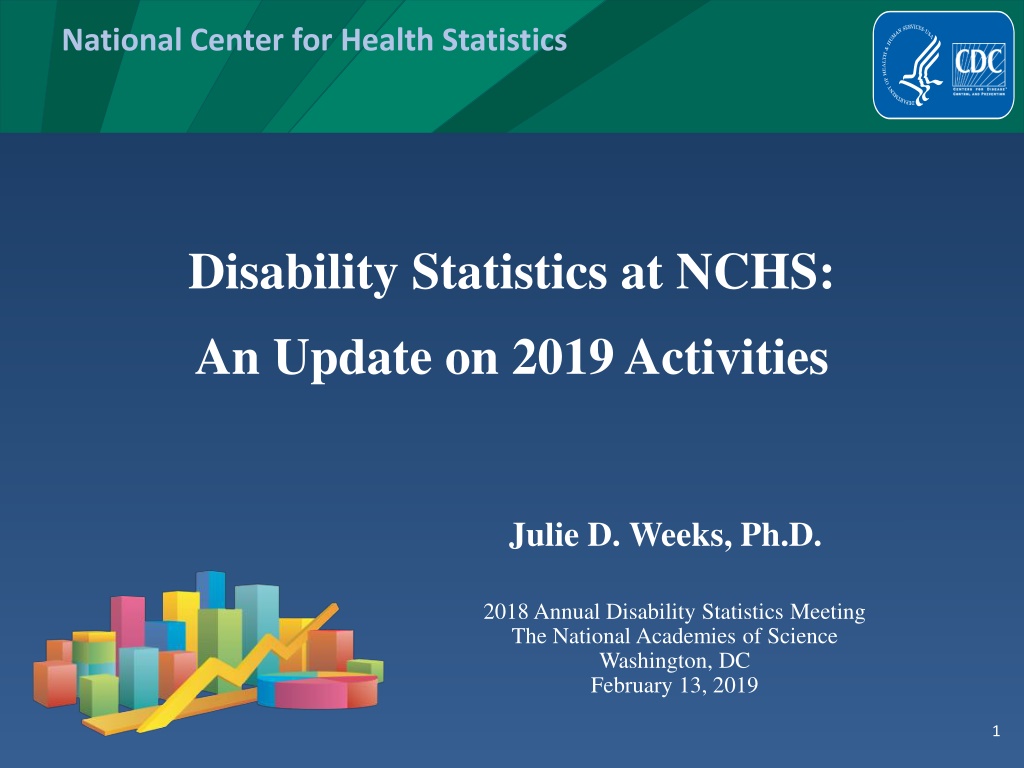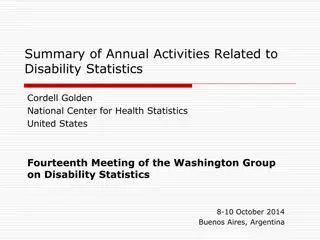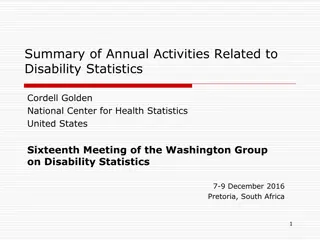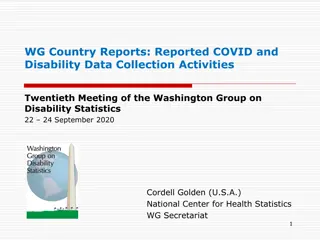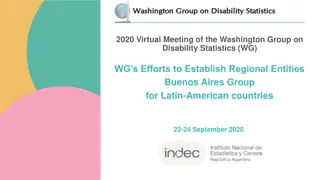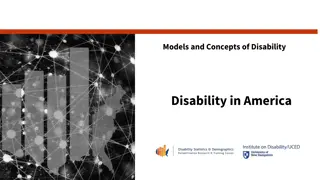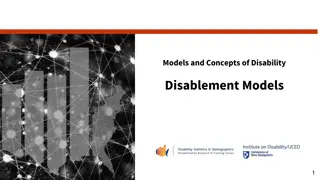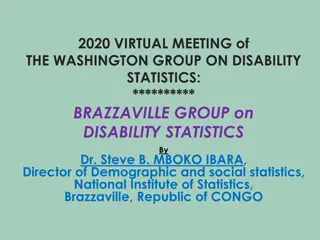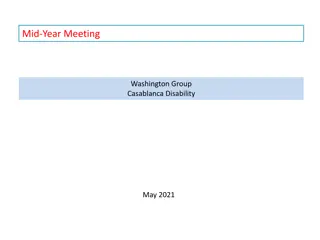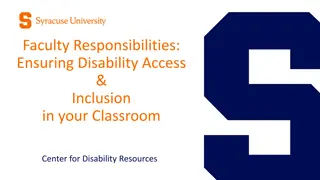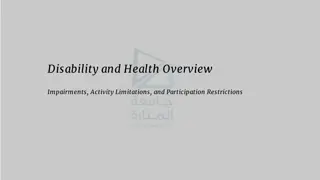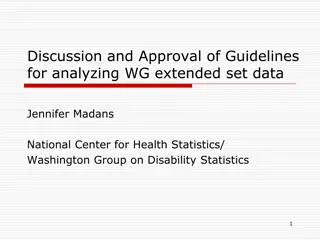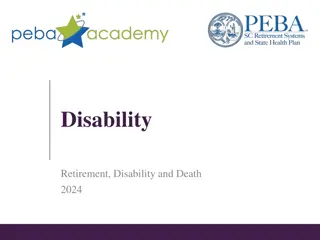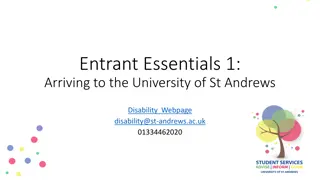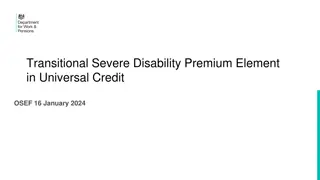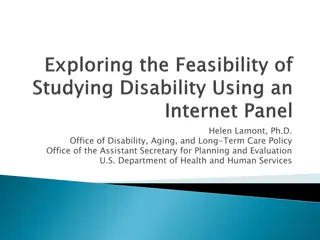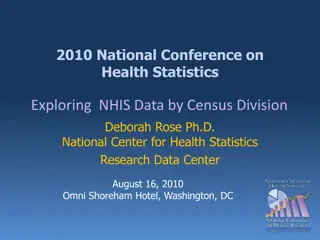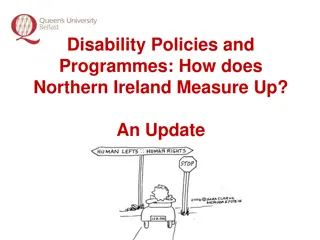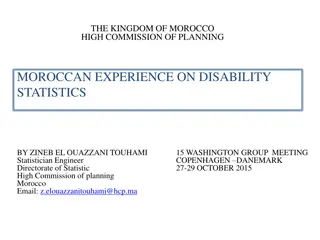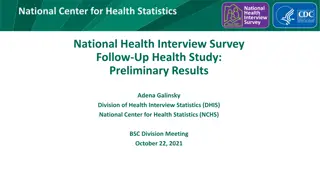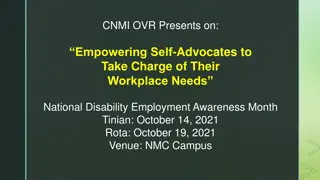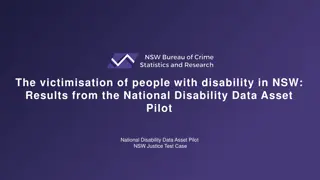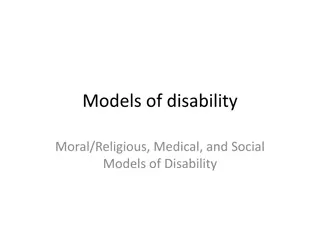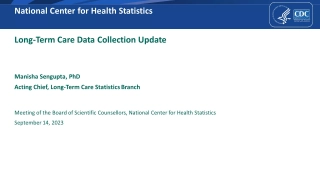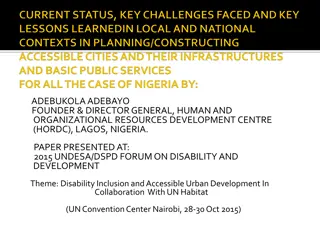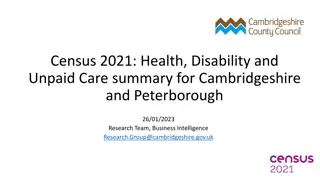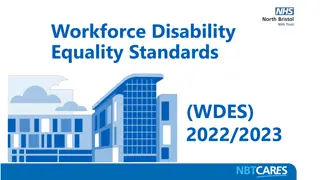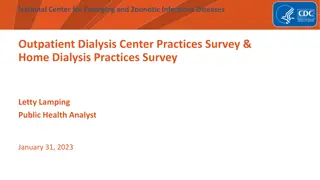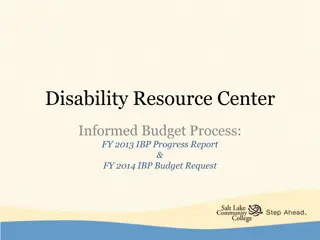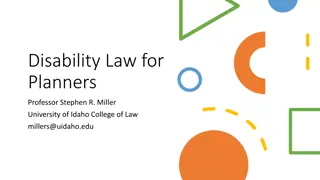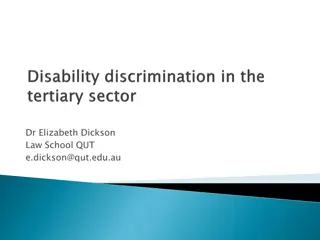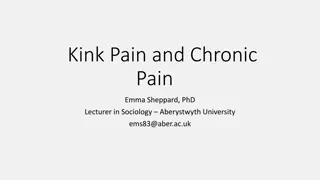Update on National Center for Health Statistics Disability Statistics Activities
The National Center for Health Statistics (NCHS) has been active in developing measurement tools such as the National Health Interview Survey (NHIS) and the National Health & Nutrition Examination Survey. These surveys aim to collect data on functioning and health conditions of adults and children. NHIS preparations included field testing and centralized training to ensure high-quality data collection. NHIS modules cover a range of topics from demographics to health behaviors, with a focus on annual core samples for adults and children. The NCHS continues to work on enhancing content and data collection methods for improved disability statistics.
Download Presentation

Please find below an Image/Link to download the presentation.
The content on the website is provided AS IS for your information and personal use only. It may not be sold, licensed, or shared on other websites without obtaining consent from the author. Download presentation by click this link. If you encounter any issues during the download, it is possible that the publisher has removed the file from their server.
E N D
Presentation Transcript
National Center for Health Statistics Disability Statistics at NCHS: An Update on 2019 Activities Julie D. Weeks, Ph.D. 2018 Annual Disability Statistics Meeting The National Academies of Science Washington, DC February 13, 2019 1
A number of measurement developments National Health Interview Survey (NHIS) Nationally-representative, annual household interview survey (30K HHs) Redesigned content launched in January 2019 (release June 2020) Adults = 18+ (self) and Children = under 18 (proxy) New functioning content National Health & Nutrition Examination Survey Nationally-representative, interview survey w/ physical exam New design: 2-year data cycle beginning 2019-2020 (release Fall 2021) Adults = 18+ (self) and Children = under 18 (proxy 5-15, self 16+) New functioning content Other functioning-related activities Special populations data collection and question development Washington Group question uptake
NHIS Preparations June 2018 Assess Q performance and interview length, as well as obtain interviewer and staff feedback. Field Test New Content (n=315) September 2018Centralized Interviewer Training Prepare interviewers to collect high-quality data using the redesigned instrument. October 2018 Bridge sample in Q4: n 9,000 each instrument (old/new) All interviewers gain pre-2019 production experience. Dress Rehearsal & Systems Test November 2018 Sample adult response rates up 5%, overall interview length within an hour, evidence of less R burden. Bridge Results January 2019 Redesign design , nonresponse bias analyses continue, 2020 content development commences. Full Implementation
NHIS Modules Annual Core - Sample Adult (n 30,000) Self-response (unless unable) Relevant family-level data Fielded with fixed periodicity Demographics, family income. health insurance, health care/utilization/ status, chronic conditions, WG functioning Annual Core - Sample Child (n 10,000) Knowledgeable adult responds for child Relevant family-level data Fielded with fixed periodicity Dental and mental health, rotating conditions, pain, detail on employment and injuries, health behaviors Rotating Core Newer topic areas Expanded detail Varying periodicity Sponsored Supplements Sustaining sponsors 1- or 2-year modules 5 min or less https://www.cdc.gov/nchs/nhis/about_nhis.htm
Annual NHIS Functioning Content Adults1 (18+ yrs) Adults2 (18+ yrs) Children3 (2-4 yrs) Children3 (5-17 yrs) Seeing Hearing Mobility Communication Cognition Self-care Seeing Hearing Mobility Communication Seeing Hearing + Mobility + Communication Cognition + Self-care Upper body Anxiety Depression Pain* Fatigue* Seeing Hearing Mobility Communication Cognition Self-care Fine motor skills Anxiety Depression Playing Controlling behavior Learning Controlling behavior Learning Coping with change Relationships 1WG Short Set on Functioning 2WG Extended Set on Functioning 3WG-UNICEF Child Functioning Modules * Pain and fatigue collected on a rotating basis.
Additional NHIS Functioning Content Work limitation: Are you limited in the kind or amount of work you can do because of a physical, mental or emotional problem? Social activity limitation: Because of a physical, mental, or emotional condition, do you have difficulty participating in social activities, such as visiting friends, attending clubs and meetings, or going to parties? Participation limitation: Because of a physical, mental, or emotional condition, do you have difficulty doing errands alone such as visiting a doctor's office or shopping? Additional mental health measures: Adults: K6, PHQ-8, GAD-7 (not at the same time) Children: SDQ, SDQ-Impact
NHANES Functioning Content Adults1 (18+ yrs) Adults2 (18+ yrs) Children3 (5-17 yrs) Seeing Hearing Mobility Communication Cognition Self-care Seeing Hearing + Mobility + Communication Cognition + Self-care Upper body Anxiety Depression Seeing Hearing Mobility Communication Anxiety Depression Controlling behavior Learning 1WG Short Set on Functioning 2WG Extended Set on Functioning 3WG-UNICEF Child Functioning Modules
Additional NHANES Functioning Content Work limitation: Are you limited in the kind or amount of work you can do because of a physical, mental or emotional problem? Social activity limitation: Because of a physical, mental, or emotional condition, do you have difficulty participating in social activities, such as visiting friends, attending clubs and meetings, or going to parties? Participation limitation: Because of a physical, mental, or emotional condition, do you have difficulty doing errands alone such as visiting a doctor's office or shopping? Additional mental health measures: Adults: PHQ-9, GAD-7
Functioning in Special Populations Children 2019 NHIS: annual collection of full Child Functioning Module 2019-20 NHANES: collection of partial CFM for 5-17yo Intellectual and Developmental Disability Updating population prevalence of IDD Question development to identify IDD population Cognitive testing of IDD questions in NCHS CCQDER
Adoption of the CFM & WG-SS UNICEF: Added the CFM to the Multiple Indicator Cluster Surveys (MICS) USAID: WG-SS included in the Demographic & Health Surveys (DHS) World Bank: WG-SS to be included in all WB-sponsored HH surveys, including the Living Standards Measurement Study (LSMS) UNSD & UNECE: WG-SS endorsed as the means for disability data collection in 2020 round of censuses - WG-SS now included in censuses/surveys in over 75 countries 2030 Sustainable Development Goals: WG-SS to be used for SDG disability disaggregation DPO and NGO Support: WG-SS endorsed by widely, in particular: IDA, IDDC, HI, Sightsavers, CBM, and others
Thank You National Health Interview Survey https://www.cdc.gov/nchs/nhis/index.htm National Health and Nutrition Examination Survey https://www.cdc.gov/nchs/nhanes/index.htm Washington Group on Disability Statistics http://www.washingtongroup-disability.com/
